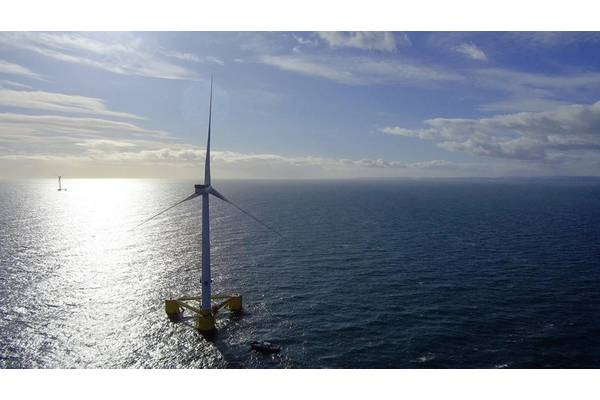
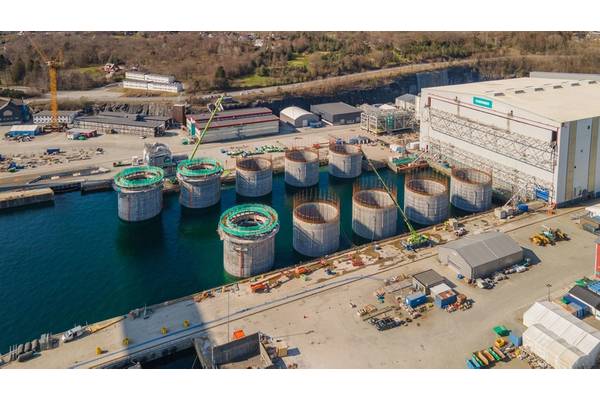
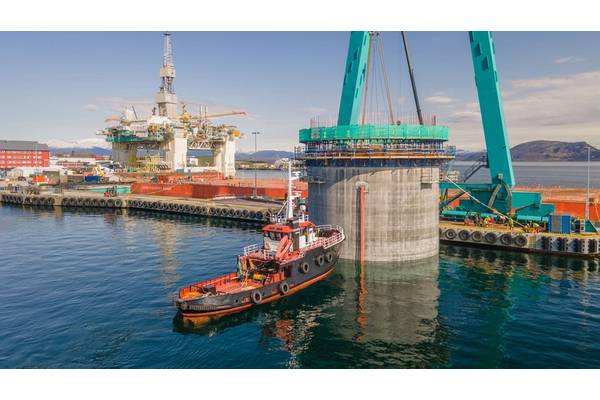
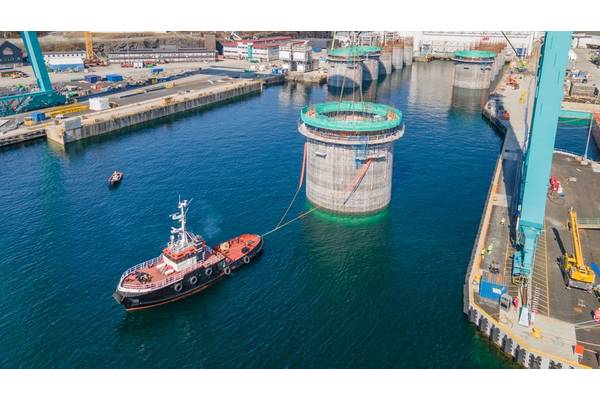
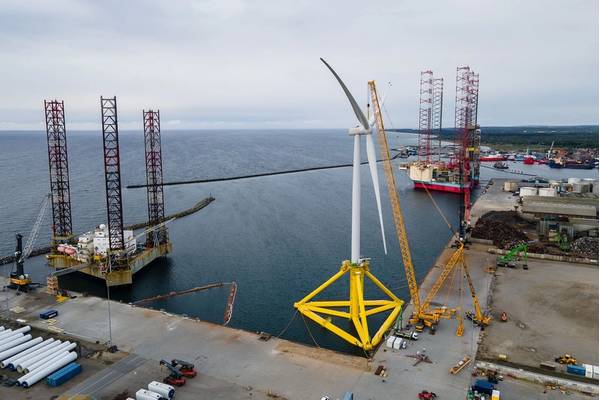
After being very much on the margins of the offshore wind industry, floating offshore wind now appears to be ready to hit the mainstream. With gigawatt scale developments already on the horizon, what will the infrastructure needed to build and support them look like?
Over the past 12 months, the floating offshore wind sector appears to have had a major dose of adrenaline. While the largest development, to date, is the relatively small-scale 50MW Kincardine project off northeast Scotland (which will be outdone by the 88MW Tampen project in Norway later next year [2022]), an ever growing number of major energy companies, from Iberdrola to TotalEnergies, have been setting forth plans for gigawatt-scale floating wind farms – all over the globe.
This year, the Global Wind Energy Council’s (GWEC) forecast for floating wind build out over the next 10 years shot up by 10GW, from the 6.5 GW estimate made last year, to 16.5 GW – and that’s a conservative number, says Feng Zhao, head of strategy and market analyst at GWEC, with more like 20 GW potentially out there.
Leading the charge are the likes of Japan and South Korea, that have set various multi-gigawatt targets, with Norway, France and the UK, which have launched floating offshore wind auctions and licensing rounds, also in the top five, says GWEC.
But while the short-term, up to 2025, is still expected to be dominated by pre-commercial projects, mostly in the tens to hundreds of megawatts, that’s not stopping many starting to plan out the infrastructure that will be is expected to be needed for the gigawatt-scale projects expected to be being built in the latter half of the 2020s. Egil Birkmoe, VP HV infrastructure, renewables, at Aker Solutions, told the conference that there will need to be thought put into ports, potentially picking ports to invest in that can be hubs. The level of activity expected means there will need to be collaboration around use of ports, Tom Glover, UK country chair at RWE, a German energy company, told the same event.
Quite what infrastructure ports will need isn’t that clear. Nancy McLean, Senior Offshore Development Manager, EDF Renewables, says, “I think port infrastructure that’s available in the local supply chain context is going to have quite a large effect on what technology is delivered geographically.” Other, like Colin McKinnon, Technical Director, Wood, agree. “There will be a certain amount of tailoring (of foundation designs) to the specific location you’re installing in.” But, “There are many ways to skin a cat and it will vary in markets and local content,” adds Stephen Bull, EVP Renewables at Aker Solutions, also speaking at the Aberdeen event, organised by industry groups RenewableUK and Scottish Renewables. Indeed, there are still a large number of foundation concepts out there – up to 40, according to GWEC. But they mostly all fit into four types; spar, semisubmersible, barge and tension leg platform. For concrete spars, there’s a need for deepwater quaysides and space for concrete slipforming, for example, while other solutions need more laydown area.
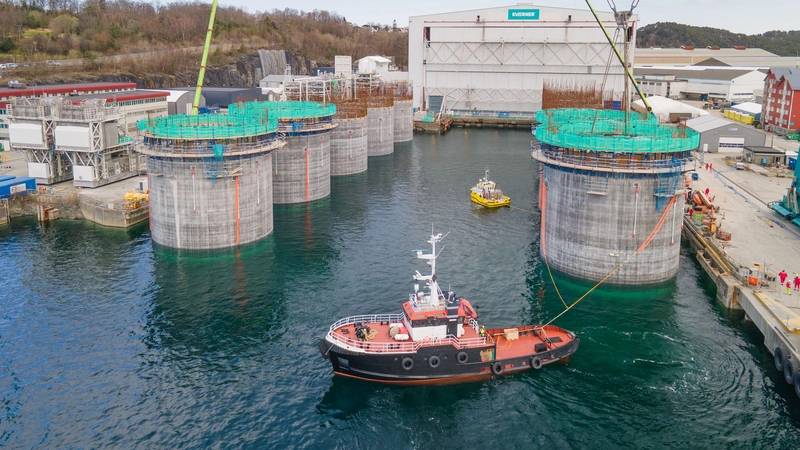 Hywind Tampen structures being floated out of the drydock at Stord, Norway. Photo from Aker Solutions / Lars Melkevik.
Hywind Tampen structures being floated out of the drydock at Stord, Norway. Photo from Aker Solutions / Lars Melkevik.
“One of the major challenges to overcome is building these structures at scale, having suitable facilities to construct floating foundations,” says Aker Solutions’ SVP for Offshore Wind, Kenneth Simonsen. “If we’re having something that’s 80m x 80m, almost like a football field, and you want to build 50, that’s a lot of acreage you will need. So we need new solutions for that construction and the whole logistics around it and I don’t think we’ve seen the optimum solutions around this yet. That’s something we’re wrestling with today.”
Stiesdal’s TetraSpar concept hopes to overcome some of these challenges. The idea is that it’s made off site in components that only need to be “pinned” together at the quayside – a process that takes just 2-3 days, compared with weeks for welded structures – before being towed out, with just 8m draft needed, says Henrik Stiesdal, the company’s founder. Jim Lanard, CEO of California focused Magellan Wind, says this is an attractive option. “The foundations can be cost-effectively made at existing wind turbine tower plants, limited time and area is needed at the ports, and that’s going to be a really important constraint that’s going to have to be overcome in California. With TetraSpar, the components can be stored offsite and we’ll bring them to site as they’re needed for assembly.”
Equinor has now taken a similar route, unveiling, in early November, its Wind Semi concept, a semi-submersible designed for easy fabrication and assembly, which it will use for gigawatt-scale projects in Scottish waters, if successful in the ScotWind leasing round.
But while being able to tow fully assembled turbines to site helps reduce reliance on what’s currently a very limited market for Jones Act-compliant installation vessels, it constrains activity to ports where there’s sufficient air draft, points out Lanard – so no overhead transmission wires or bridges, as well as sufficient water depth.
For all types of floater, onshore assembly then complete turbine tow-out to site is seen as the predominant construction method, eliminating the need to use costly heavy lift and installation vessels and even the pressure to ship out towers and blades in multiples for offshore installation. But it does create a new need; for big investment in onshore cranage, says Colin McKinnon, Technical Director, at engineering group Wood. For the 8MW Hywind Tampen, a Mammoet crane had to be hired in to the Wergeland Group assembly yard, north of Bergen, where assembly operations will be carried out. Not too far into the future, cranes able to lift the 15MW and then 20MW turbines and blades into place will be required.
Many are gearing up for a slice of the action. In Scotland, the aforementioned ScotWind round has spurred activity around port infrastructure. The round received 74 applications that could translate into 7GW of floating offshore wind in the next 10 years (with winners due to be announced early next year), Miriam Noonan, analysis and insight manager at the UK’s ORE Catapult told the Aberdeen event. Crown Estate Scotland also has a separate lease round aimed at using wind farms to dercarbonise offshore oil and gas infrastructure. Ports at Leith and Peterhead have announced major redevelopments to accommodate floating offshore wind projects, with Peterhead also signing an agreement with partners Falck Renewables and BlueFLoat Energy, to look at construction and O&M options for floating projects. Forth Ports has announced £40 million investment in its Edinburgh site, including dredging, to accommodate floating turbine construction and O&M. Developer BW Ideol has also agreed a partnership with Ardersier Port Authority for building concrete floaters. If successful with its ScotWind bid, TotalEnergies has pledged cash towards enhancing ports and harbour infrastructure in Orkney and Caithness, in Scotland. The NextGen consortium (Aker Offshore Wind and Ocean Winds) announced plans to create a new fabrication yard, if they win their ScotWind bids. Operators of the NIgg facility in the Cromarty Firth and Dundee are also planning expansion. You get the picture – there’s no end of activity to capture floating wind work in Scotland – although a lot rides on winning bids.
But the action is not just in Scotland. The UK government has announced a £160 million funding pot for ports and factories for large-scale floating offshore wind buildout. In Spain, Capital Energy has signed two memorandums of understanding (MoUs) with the Astican and Zamakona shipyards in the Canary Islands to provide facilities for the development of floating offshore wind projects. In Taiwan, partnerships are also being built to further floating projects. Flotation Energy, for example, agreed an MOU with China Ship Building Corporation to explore local supply chain opportunities in floating offshore wind, from design through to manufacturing and O&M.
Over in the US, state bills in California and Oregon are spurring activity. Oregon is looking at a 3GW by 2030 target and wants to coordinate port activity. California, likewise, has laid out a road map for port infrastructure. The Port of Humboldt Bay (the largest deepwater port between San Francisco and Coos Bay, Oregon) is targeting $55 million spending on an infrastructure development program to support offshore wind, including an all-electric heavy lift terminal, while a site in Oregon, which had been earmarked for an LNG facility, is now being assessed to support floating offshore wind instead, says Jamie MacDonald, Director of Operations (Boston), at Xodus Group. It might not be long until ports supporting floating offshore wind are also considering landing hydrogen from those wind farms, potentially.
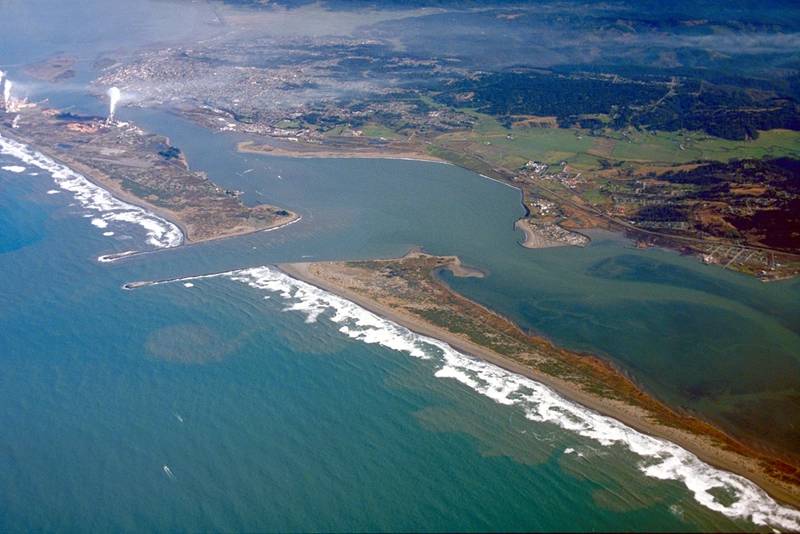 Humbolt Bay. Robert Campbell - U.S. Army Corps of Engineers Digital Visual Library. CC BY-SA 3.0.
Humbolt Bay. Robert Campbell - U.S. Army Corps of Engineers Digital Visual Library. CC BY-SA 3.0.
Lanard says that, after four years of stagnation – partly due to US military concerns about use of west coast waters – there’s now momentum in this area, with the Biden administration, via BOEM, planning lease rounds in California and Oregon in 2022 and 2023, respectively.
But pressure on ports will not just be about assembly and marshalling. Operators are already thinking about operations and maintenance (O&M) strategies for their new floating wind parks. “If we’re currently thinking that the turbines are going to be needed to be towed back to port for maintenance and major component repair, then that’s going to be a conflict with the use of port,” says McLean. “If we’ve got some ports involved in producing lots of foundations and marshalling for construction and installation and we’ve also got operations and maintenance activities and major component repairs that need to be undertaken, that’s going to be a conflict for deepwater port access.”
A large question mark also remains over how O&M will be done. Currently the consensus is to tow units back to shore, but it’s not clear if this is a long-term solution. “One of the big things that is still missing in the puzzle is the good way of doing large component replacement or maintenance of large components on floating wind farms. The ones that can come up with the good solutions for that, there’s an enormous market there.” Could that be a completely new vessel concept? Some think so, but others also think that technology will come into play that enables O&M offshore, including access solutions.
Despite the many questions that still remain, there’s definite momentum in this sector. Many are confident the industry will see the cost reduction it needs to get it on par with fixed bottom offshore wind. The World Bank, for example, has said floating “is likely to be cost competitive” with fixed bottom offshore wind by the mid-2030s. Indeed, Noonan says, “Cost reduction is expected to happen even faster for floating than it did for bottom fixed and we expect scale and innovation could take us to subsidy free projects by the early 2030s.” Margulis points to US National Renewable Energy Laboratory predictions that put costs at $53-64/MWh by 2032. “The cat is out of the bag here and there’s no letting it back in,” Lanard says. Expect to hear much more about floating offshore wind in the future.
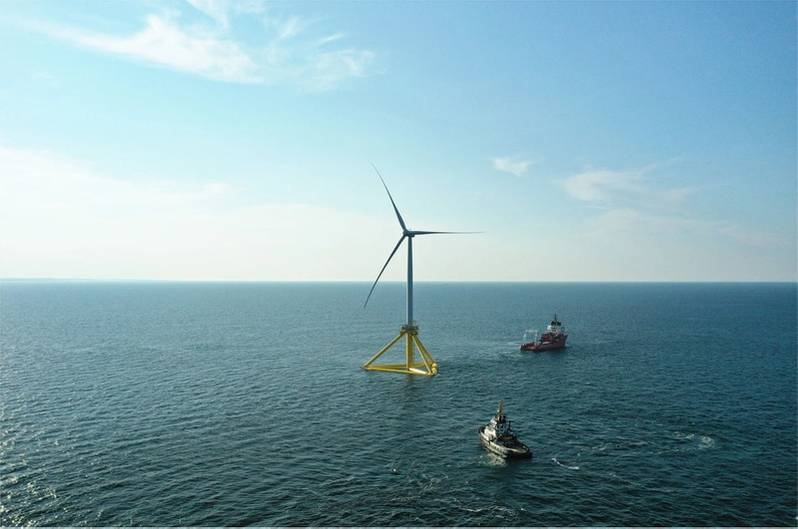 Construction and installation of Stiesdal’s TetraSpar Demo in Norway. Photos from Stiesdal.
Construction and installation of Stiesdal’s TetraSpar Demo in Norway. Photos from Stiesdal.



